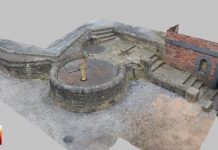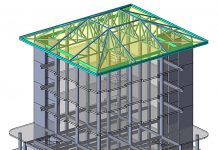In an interview with Lisa Carnwell, Editor of BIM Today, David Philp, industry sector BIM ambassador, discusses the UK’s BIM journey and his latest role with the Scottish Futures Trust
Anyone aware of BIM will know who David Philp is, but for any newcomer to the idea of digitising construction and especially BIM, Philp is certainly one of the top influencers and ambassadors for the sector.
In the early nineties, he joined Balfour Beatty as a graduate engineer, eventually becoming their Director of Technical Services and latterly BIM Programme Director. He has worked for Mace as Head of Building Information Modelling and is now Director for BIM at AECOM. But that’s not all. He is a Professor at Glasgow Caledonian University and following a secondment into the Cabinet Office’s Efficiency and Reform Group in 2011 he remains Head of BIM at the UK BIM Task Group. A co-founder of BIM2050 and BIM4SME he is chair of the various BIM4 working groups in addition to being recently announced as the Chair of the BIM Delivery Group for the Scottish Futures Trust.
I was lucky enough to grab some time with one of the busiest people I’ve ever met to discuss BIM and the whole concept of digitising construction. We began with discussing the current thinking within the industry and where the UK sits in terms of BIM implementation.
Where are we now?
Although many people are aware of the Digital Built Britain programme, industry is still very much focussed on Level 2 and ensuring it is embedded before thinking about Level 3 BIM. There are a comprehensive suite of standards, processes, guidance and tools which will be complete around October, including the last piece of the jigsaw in terms of the soft landings standard. It is expected that the NBS BIM Toolkit will have advanced by that point too, with significant testing.
For Philp, the deadline for government to have all centrally procured projects achieve Level 2 BIM in 2016 is a starting point. He said:
“Everyone talks about getting to 2016 like its crossing a finish line, but it’s actually when we start the race. We have clients that are geared up to put Level 2 into the marketplace and we have all the standards and processes which are all tested, but perhaps most importantly, they are proven.
“From an international viewpoint, we are seeing more of our standards being used – so not just adopted within these shores. Clients from abroad such as in the Middle East are taking elements like PAS 1192-2, proving that in terms of global leadership, the UK is well-placed to capitalise and exploit our knowledge.
“If you put a lens over the UK in terms of what we have and what sets us apart, it’s that clients are creating mandates, which is a big step. We can also discuss different levels of maturity whereas other countries are discussing this rather nebulous concept called BIM.”
We still have some way to go though. Philp wants more case studies and guidance, which doesn’t necessarily have to come from institutes such as PAS, but from others who are interested in the idea of digitisation of the discipline, and who are thinking more about digitising information management.
PAS 1192-5 Mindful security
This latest standard has now been published recognising the huge value of data sets and what is shared. It is being hailed as ‘a crucial component in Level 2 BIM and its publication marks a key milestone in the programme. It will enable BIM to be mobilised and implemented in a security-minded way whilst still realising the benefits of collaborative and digital working.’
As organisations embrace collaborative working, not only through greater openness and transparency, but also through the sharing and use of detailed models and large amounts of digital information, they must also recognise that the increasing use of, and dependence on, information and communications technologies does create some vulnerability issues.
According to an article placed in the BIM Taskgroup Newsletter in July 2015;
“Being security-minded is not about inhibiting collaboration, but instead adopting an appropriate, proportionate, need-to-know approach to the sharing and publication of data and information in order to deter and/or disrupt hostile, malicious, fraudulent and criminal behaviours and activities. In so doing in the fields of architecture, construction and engineering, the industry is better able to deliver the trustworthiness, safety and security of digital built assets.”
Philp believes that;
“We have to be more mindful of what we are protecting in terms of both the physical built asset and the digital information. If you think of Level 2 as an onion, PAS 1192-5 sits right on the outer skin. To come further in, you have to pass through there, so you have to have that mindful approach to digital technologies. For me it does two things. It gives you the screening – making sure you’re doing it right, but at the same time it’s a companion to help do this in a mindful manner. It’s all about the decision making process – the assessment of needs and taking the proportionate measures.”
Is industry ready to meet the requirements of Level 2?
BIM was brought to industry attention in the UK Government Construction Strategy published in 2011. Since then the BIM Task Group has been developing standards and requirements to enable BIM adoption. For Philp they have come a huge way in terms of digitalisation:
“We are trying to reach 3 million people and help them start their journey. When you go to conferences now, people are talking about soft landings, operational data sets and Cobie etc. How many folk were having this conversation back in 2011?” he said.
“I really think we have started to nudge industry in the right direction and I genuinely believe that by the time we reach March 2016, we will be well-placed in terms of achieving what we set out to do with the BIM mandate.”
Philp refers to how Level 2 can be achieved easily:
“A Level 2 project should be set out well by the client, with the right leadership, with the EIR, and the right framework – which is often behavioural. It’s also important that the supply chain is moved on in terms of upskilling and their capability is tested. The requirements are quite simple really when you break it down as to what you’re asking the supply chain to do – you’re just asking to share information in a Common Data Environment and manage information in a structured process. If you take the word BIM out of that – it just makes common sense.”
Philp believes that it’s inevitable that the industry (at all levels) will be digitised. He refers back to when the ‘internet’ was first mentioned, and whether it would be useful in their business. That was only 15 years ago. “We are now at the point where almost everyone has a mobile phone or an iPad type device using it as part of their day-to-day business. As simple as this sounds, this means they are working in a digital environment.”
The challenges of skills and expertise
A total digitisation of the construction industry at a simple level (such as just using a mobile phone) shouldn’t be an issue. However, being able to utilise BIM at Level 2 and beyond is a challenge. Philp agrees, and thinks that academia has to address digitised construction into under-graduate courses. The current situation in terms of post-graduate integrated design is doing well, but school leavers will want to know if there’s a great course that is innovative – and that includes apprentices too, understanding that we need to make the construction sector attractive in terms of a career path.
How important is accreditation?
Proving that you are BIM capable should help to secure future business, but is it that simple? Philp said:
“We love our badges don’t we?! But I do agree that we need the creation of an industry data mass that gives some consistency.
“We have a good pre-qualification process in the UK, but Level 2 is not just about individual members, but a coherent supply chain you assemble for that project. You may have an organisation that has some certification, but unless you have everyone working together on a project, it could be somewhat meaningless.”
What next: The Scottish Futures Trust and why they need a BIM strategy
The need for a BIM strategy for Scotland was essentially borne out of the report of the Review of Scottish Public Sector Procurement in Construction (published in October 2013). This independent construction review looked at how public bodies involved in construction-related procurement can adopt practices that are streamlined and deliver value for taxpayers’ money.
The Scottish Government has joined up with the Scottish Futures Trust (SFT) to deliver the recommendations, one of which is for BIM to be achieved within the public sector by 2017. The SFT is leading that initiative and is working on developing a strategy for a mandate.
Philp will be joining that initiative as Chair of the BIM Delivery Group. He said that:
“I’m coming in with the hindsight of all those years of the good, the bad, and the ugly side of BIM and looking at the lessons learned. I’ve been able to ask people such as Malcolm Taylor and Paul Morrell how they would have done anything different in terms of policy and processes, etc.
“The good thing is that a lot of the heavy lifting is already done. Level 2 as a British standard is in place, so how do we configure that to make it suitable for the Scottish public sector procurer? Essentially, we have to examine the guidance we produce and implement the lessons learned from sectors such as oil and gas as they are pretty well advanced in terms of how they think about digitised information management and how they manage their assets.
“We want to make sure we address appropriately the recommendations and start to build a potential roadmap and implementation strategy for Level 2 BIM by 2017 on all public sector projects.” He continued.
Implementing a BIM strategy is expected to deliver positive results for Scotland including:
• Better procurement;
• A more efficient and sustainable built environment;
• Better places to live;
• More intelligent infrastructure – something that is fit for 21st Century Scotland.
Philp wants the strategy to be outcome driven, examining what is required for 2017, but also beyond that date.
“We will be setting up communities of working groups to help inform what the strategy will look like. We are already seeing early adopters like NHS Scotland who are already well on their journey helping to upskill their procurer base. They’ve been involved in workshops all round Scotland and they have all their Level 2 artefacts in place, so we are seeing advancement already and that is pre-mandate.
“There’s a mature supply chain in Scotland too. Many organisations have worked on Level 2 projects elsewhere and there is a sense of needing to take the journey further. Of course, the BIM Task Group and the Digital Built Britain team will help to ensure the strategy is aligned and to try and harmonise it with any international thinking and standard as well” he said.
Working on the mandate will mean breaking areas down into manageable programmes such as trying to understand the client perspective and being sure to test appropriateness from all the recommendations that were set out within the public sector review. Philp continued:
“We have to make sure we have our narrative right, making sure people know what will be expected by 2017, if not before. This is a great opportunity for Scotland to move into the digitised space and create new offerings. I’m looking forward to helping Scotland create a digital future for the Scottish built environment.
His parting comments are one of encouragement for the construction sector;
“I’m passionate about change. My journey in BIM keeps changing as to what it means, and if anything, it has become a metaphor for industry change and for more innovative working.”
David Philp
Director for BIM at AECOM
Head of BIM at the UK BIM Task Group
Chair of the BIM Delivery Group for the Scottish Futures Trust
www.scottishfuturestrust.org.uk













